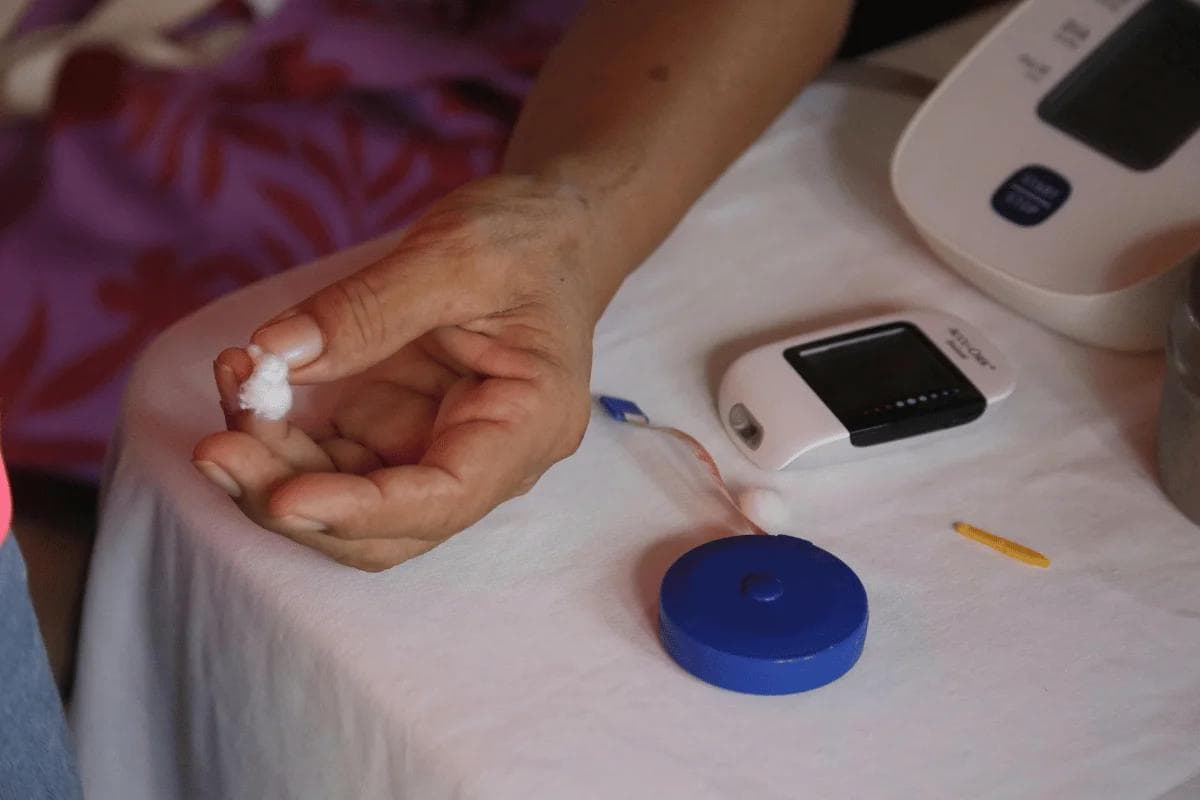
Chronic Disease Management In Primary Care: 2025 Guide

Author
Digital health marketing professional with over 10 years of experience bridging clinical and wellness spaces by leveraging innovative technologies, behavioral change programs, and strategic digital marketing.
Managing chronic illnesses requires a long-term, patient-centric approach to enhance your patients’ quality of life. As a primary care provider, you’re uniquely positioned for this role. You can deliver continuous high-touch care that balances evidence-based medicine with each patient’s unique circumstance. However, rolling out chronic disease management in primary care in this manner, given the sheer volume of patients and the complexity of clinical guidelines, requires system-level solutions. In this post, we’ll explore the role of primary care providers in chronic disease management, detailing steps to improve outcomes and how technology solutions can boost patient engagement and adherence.
What Does Chronic Disease Management Mean?
Chronic Disease Management (CDM) is an integrated, continuous, patient-centered care approach designed to deliver superior outcomes for individuals with long-term conditions.
The goal is to slow the condition’s progression, minimize its impact on the patient’s daily life, and reduce the cost of care through ongoing coordinated care. It also involves the prevention and early detection of acute events.
A primary care provider rolling out CDM must focus on the following components of care delivery:
- Establish individualized treatment plans.
- Utilize technology to track patient data and adherence.
- Build systems for regular remote check-ins with patients.
- Empower patients to take an active role in managing their condition.

Common Chronic Conditions Seen in Primary Care
Chronic conditions that commonly feature in primary care include:
- Obesity
- Diabetes
- Arthritis
- Hypertension
- Hyperlipidemia (high cholesterol)
- Mental health conditions like depression and anxiety
- Heart/cardiovascular disease, like heart failure and coronary artery disease
- Chronic respiratory disease, like asthma and chronic obstructive pulmonary disease
Many of these conditions are prevalent among seniors. Moreover, multimorbidity is common.
For instance, a patient with diabetes may also have hypertension. As such, Medicare provides resources through its Chronic Care Management (CCM) program to help providers effectively manage comorbidities.

Role of a Primary Care Physician In Managing Chronic Illness
The primary care physician fulfills a critical role as the central coordinator in the patient’s healthcare journey.
Good coordination is essential, as the typical patient often sees several specialists, such as endocrinologists and cardiologists. The primary care physician must ensure that communication is clear and that specialist recommendations align with the patient’s overall care goals.
Other roles of the primary care physician in the management of chronic illnesses include:
- Hollistic assessment: With a comprehensive assessment approach, the physician doesn’t just evaluate one disease but assesses the “whole” patient, e.g., mental health, functional status, and comorbidities. They also screen for social determinants of health, such as housing instability, that may impact outcomes.
- Risk stratification: The primary care physician categorizes the patient based on the severity of their condition, taking into account factors such as the risk of hospitalization and potential for adverse events.
- Development of individualized care plans: While care should follow evidence-based guidelines, the primary care physician can individualize care plans to factor in the patient’s comorbidities and life circumstances. Additionally, collaborative goal setting can help patients make progress toward goals that matter to them, such as achieving a functional status that allows them to return to a hobby.
- Patient education and empowerment: Health literacy can significantly impact outcomes. The primary care physician should ensure the patient understands their condition and medications, as well as the reasons behind the individualized care plan. Additionally, they should help the patient adopt healthy lifestyle habits.
As the central coordinator, the primary care physician should also lead the effort to integrate technology for remote patient monitoring and care delivery.

How Technology and Data Support Chronic Disease Care
Increasing integration of technology in CDM is helping make chronic care continuous and proactive.
Let’s explore how technology and data support chronic disease management:
- Enables continuous monitoring: Remote patient monitoring (RPM) platforms allow providers to get real-time insights into patient vitals. For instance, in RPM for diabetes, you can use continuous glucose monitors and cellular glucometers to record and transmit real-time glucose levels.
- Enables proactive intervention: With real-time readings available, providers can act quickly when readings are out of range, preventing adverse events before they occur. KangarooHealth, for instance, includes tailored escalation protocols that generate tiered alerts so you can quickly address issues that require immediate attention.
- Improves patient engagement: RPM and CCM services enable patients to become active participants in their own care journey. A close, collaborative relationship between the patient and their care team helps improve adherence and satisfaction.
- Expands access to care: There’s a demographic and income divide when it comes to access to care. For instance, 20% of the population lives in rural areas while only 10% of physicians practice there. Technology is helping address this rural healthcare crisis by enabling patients to receive healthcare remotely.
- Streamlines coordination: Integrating the health systems helps address several problems associated with fragmented care. To ensure the primary care physician and specialists are operating from one “single source of truth”, RPM platforms centralize all patient data, including medical history, diagnoses, lab results, medications, and care team notes.
Additionally, a key way remote patient care solutions are revolutionizing chronic disease care is that they often come equipped with data analytics features.
KangarooHealth transforms raw incoming data into actionable insights to guide health management. You receive categorized and tiered alerts, helping with risk stratification - identifying high-risk patients and allocating more resources to them quickly.

How to Improve Management of Chronic Disease In Primary Care
It’s best to adopt a patient-centered and proactive care model when helping patients manage long-term conditions.
Based on this approach, here are some of the strategies you can adopt to improve the management of chronic diseases:
- Implement coordinated care: Chronic care often requires a multidisciplinary team. You can strengthen coordination by establishing a collaborative team, clarifying and optimizing roles, and using structured communication to ensure all players are aligned on the patient’s and team’s goals.
- Provide self-management support: The patient should take ownership of their healthcare journey and be an active participant in it. Therefore, you should foster shared decision-making, enhance the patient’s health literacy, and actively help the patient address adherence barriers.
- Connect the patient to community resources: Community resources can help the patient address social determinants of health, such as food insecurity, lack of housing, and financial distress. You can connect the patient to community health workers and social workers, as well as resources such as food banks and community support groups.
Further, modern tools can help you deliver chronic care proactively and continuously. Leveraging technology, you can integrate chronic care management tools with your Electronic Health Record to track the progress of your patients, monitor adherence, and get real-time data to arrest acute events before they happen.
With KangarooHealth’s Remote Patient Monitoring (RPM) solutions, you can use digital devices and a cloud-based app to track your patients' vital signs (such as blood pressure and glucose levels) from their homes.
Our platform enables you to intervene proactively whenever readings are out of range, tailor care to each patient’s specific needs, and increase access to care for patients in underserved populations, such as rural areas.
Schedule a free consultation with our team today to see how our remote patient care solutions can help you improve chronic disease management in primary care.

Tips to Measure Outcomes And Driving Continuous Improvement
Driving continuous improvement requires first defining what success looks like and taking a structured, data-driven approach to steadily move towards those health and patient outcomes.
Let’s explore some ways to measure outcomes and drive quality improvement:
- Establish a baseline for performance: Track patient-centered, process, and outcome metrics to capture baseline data on the full scope of chronic disease management in primary care.
- Set SMART goals: Define ideal performance levels for each metric. Goals should be Specific, Measurable, Achievable, Realistic, and Time-bound (SMART).
- Adopt a practical framework for quality improvement: Adopting a consistent quality improvement methodology, such as the Model for Improvement or Plan-Do-Study-Act (PDSA), can help you quickly test the effects of various interventions, making rapid iterations possible.
- Leverage technology: Utilize EHRs and patient care platforms like KangarooHealth to collect clinical and operational data. Over time, you’ll have reliable insights to help distinguish between normal variations and actual long-term improvements.

Frequently Asked Questions (FAQs)
Let’s now address some of the common questions we receive about the management of chronic disease in primary care:
How Do Primary Care Physicians Collaborate with Specialists?
Primary care physicians and specialists can share patient data and information through a well-organized platform, often through an EHR or a CCM platform like KangarooHealth.
What are the Essential Components Of a Comprehensive Care Plan?
A comprehensive care plan will typically include the following components:
- Initial patient assessment and clinical diagnosis
- Capturing relevant health data in the health information system
- Clarification of care goals and desired health outcomes
- Planning and roll-out of interventions and services
- Continuous review and evaluation
How Does CCM in Medical Practice Improve Patient Care?
CCM primarily targets patients with multiple chronic conditions. The key benefit of chronic care management is that it helps make care delivery continuous and proactive, rather than episodic and reactive.
Additionally, it facilitates coordination of care among different specialists when attending to a patient with comorbidities.
Conclusion
We’ve explored what it takes to achieve optimal chronic disease management in primary care, from defining the primary care physician's roles to measuring outcomes for continuous improvement.
A key takeaway is that primary care physicians must master patient-centered care, collaboration, and improvement through metrics. However, you cannot improve chronic care if you don’t have visibility into the effects of your interventions.
With KangarooHealth, you can now gain real-time visibility into critical metrics and outcomes, including blood pressure control, HbA1c, and patient engagement.
Book a free demo to see how our all-in-one platform can help you roll out remote clinical monitoring and support, improve patient engagement and adherence, and reduce administrative burden.

Sesily Maness
AuthorDigital health marketing professional with over 10 years of experience bridging clinical and wellness spaces by leveraging innovative technologies, behavioral change programs, and strategic digital marketing.
Other articles you might find interesting

Remote Patient Monitoring (RPM) brings care into patients’ homes, giving providers continuous insight into health, strengthening connections, and enabling early interventions before small issues become serious. With growing adoption and Medicare reimbursements topping $500 million in 2024, oversight and compliance are more important than ever. Strong RPM programs, like those supported by KangarooHealth, combine clinical integration, clear documentation, and patient engagement while avoiding common pitfalls such as enrolling patients without an established relationship, overusing devices, or treating monitoring as passive. When thoughtfully implemented and paired with programs like Chronic Care Management (CCM), RPM delivers meaningful outcomes for patients with chronic conditions and supports rural and underserved communities while ensuring programs remain compliant and patient-centered.

Chronic Care Management goes beyond traditional treatment, ensuring continuous, personalized support for patients. Discover its benefits, long-term impact, and evolving role in healthcare.

Wondering how CCM and RPM work together? This blog breaks down their roles, benefits, and the strategies to successfully implement combined programs in healthcare.